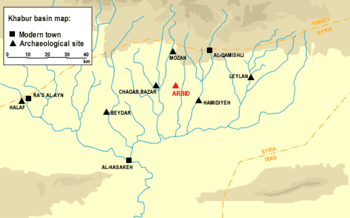Chagar Bazar
Chagar Bazar (Šagir Bazar, Arabic: تل شاغربازار) is a tell, or settlement mound, in northern Syria.
تل شاغربازار | |
 Shown within Syria | |
| Location | Al-Hasakah Governorate, Syria |
|---|---|
| Coordinates | 36.875971°N 40.897942°E |
| Type | settlement |
| History | |
| Founded | ca. 6,000 BC |
| Abandoned | ca. 2,000 BC |
| Periods | Neolithic |
| Cultures | chagar culture |
| Site notes | |
| Excavation dates | 1935—1937 1999—2002 |
| Archaeologists | Max Mallowan University of Liège Syrian Directorate-General of Antiquities and Museums |
| Ownership | Public |
| Public access | Yes |
History of archaeological research
Chagar Bazar was excavated by the British archaeologist Max Mallowan, with his wife Agatha Christie, from 1935 to 1937.[1][2][3] Many of the artefacts discovered were brought to the British Museum. Besides pottery, a large number of clay tablets written in cuneiform script were discovered. Work was resumed at the site in 1999 by an expedition from the British School of Archaeology in Iraq in cooperation with University of Liège archaeologists and the Syrian Directorate-General of Antiquities and Museums.[4][5] [6]During these excavations, which ended in 2002, 214 cuneiform tablets were recovered.
Chagar Bazar and its environment

Chagar Bazar is located in Al-Hasakah Governorate, approximately 35 kilometres (22 mi) north of Al-Hasakah, on the Wadi Dara, a tributary to the Khabur River. The ancient site measures approximately 12 hectares (30 acres).
Occupation history
Chagar Bazar was already settled in the Neolithic. Excavations revealed pottery belonging to the Halaf and Ubaid cultures. [7] By the Early Bronze Age, in the third millennium BC, Chagar Bazar had turned into a small town with the size of 12 hectares / 30 acres. The site appears to have been abandoned by the end of the third millennium BC. It was resettled and was known as Asnakkum at the beginning of the Middle Bronze Age.[8] Hurrians also occupied the city and fine examples of the Khabur ware pottery dating to this period have been discovered by the excavators.
Notes
- M.E.L. Mallowan, Excavations at Chagar Bazar and an Archaeological Survey of the Habur Region of North Syria 1934-5, Iraq, vol. 3, no. 1, pp. 1–85, 1936
- M.E.L. Mallowan, Excavations at Tall Chagar Bazar and an Archaeological Survey of the Habur Region, Second Campaign 1936, Iraq, vol. 4, no. 2, pp. 91–177, 1937
- M.E.L. Mallowan, Excavations at Brak and Chagar Bazar, Iraq, no. 9, pp. 1–259, 1947
- Augusta McMahon, Onhan Tunca, and Abdul-Massih Bagdo, New Excavations at Chagar Bazar 1999–2000, Iraq, vol. 63, pp. 201–222, 2001
- A.M. McMahon, C. Colantoni and M.J. Semple, British excavations at Chagar Bazar, 2001–2002, Iraq, vol. 67, no. 2, pp. 1–16, 2003
- McMahon, A., C. Colantoni, J. Frane, and A. Soltysiak, Once There Was A Place: Settlement Archaeology at Chagar Bazar 1999-2002, London, British Institute for the Study of Iraq, 2009 ISBN 978-0903472272
- W. Cruells and OP Nieuwenhuyse, The Proto-Halaf period in Syria. New sites New data., Paléorient, vol. 30, no. 1, p. 47–68, 2004
- Cyrus Herzl Gordon; Gary Rendsburg; Nathan H. Winter (2002). Eblaitica: Essays on the Ebla Archives and Eblaite Language, Volume 4. p. 90. ISBN 978-1-57506-060-6.
See also
- Cities of the Ancient Near East
- Tell Brak
- Hurrians
- Come, Tell Me How You Live
References
- C. J. Gadd, "Tablets from Chagar Bazar 1936", Iraq, vol. 4, no. 2, pp. 178–185, 1937
- C. J. Gadd, "Tablets from Chagar Bazar and Tell Brak 1937–38", Iraq, vol. 7, pp. 22–61, 1940
- Philippe Talon, "Old Babylonian Texts From Chagar Bazar", FAGD/ASGD, 1997, ISBN 90-90-10838-6
- J. E. Curtis, "Some Axe-Heads from Chagar Bazar and Nimrud", Iraq, vol. 45, no. 1, pp. 73–81, 1983
- O. Tunca et al., Chagar Bazar (Syrie) I: Les sondages prehistoriques (1999–2001), Peeters, 2006, ISBN 90-429-1796-2
- O. Tunca et al., Chagar Bazar (Syrie) II: Les vestiges post-akkadiens du chantier D et etudes diverses, Peeters, 2007, ISBN 90-429-1948-5
- O. Tunca and A. Baghdo, Chagar Bazar (Syrie) III: Les trouvailles epigraphiques et sigillographiques du chantier I (2000–2002), Peeters, 2008, ISBN 90-429-2089-0